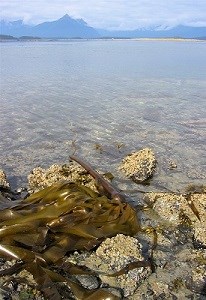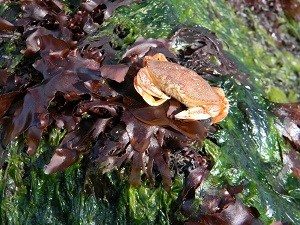
The plant life found along the beach follows zonation and exposure patterns like those that govern the distribution of animals. Although there are many species of marine plants, a few of the most common are described here. Algae, or seaweeds, are classified on the basis of the photosynthetic pigments they use. Green algae use chlorophyll like terrestrial plants. The red and brown algae also use chlorophyll, but its color is masked by other photosynthetic pigments. The most common brown seaweed is rockweed (Fucus), which is found attached to rocks throughout the middle intertidal zone. Gas-filled bladders at the tip of each branch help keep the plant floating near the surface when the tide is in, and thus increases the amount of light available for its energy needs. Light is filtered out rapidly as it passes through water. Rockweed also secretes a mucus-like substance which helps keep it moist during low tide. 
Alaria, another large brown algae species, is also found in these large beds and on the dock floats. It has a blade up to 20 feet long, with a central rib. It has a short stem with many shorter reproductive blades at the base. It also has a root-like holdfast by which it attaches itself to solid surfaces. A common red seaweed is Porphyra. This is found in the middle and upper zones, sometimes growing on rockweed. It is a very thin seaweed and composed of only one or two layers of cells. It will completely dry out during a low tide, but when the water comes back in it quickly returns to its healthy state. Another common red seaweed is Gigartina. Found on rocks in the mud and low zones, it is dark red in color and its roughened blades are covered with small palp-like reproductive structures. Several types of green algae will be seen in rocky and muddy areas. In the middle and lower zones the sea lettuce can be seen. These algae are bright green with thin broad blades, about 6 inches long, sometime perforated with many holes. Very common in the high intertidal, particularly in areas of fresh water runoff, is the long narrow and tubular Enteromorpha, up to 5 inches long but only ¼ inch wide. 
|
Last updated: March 16, 2018
